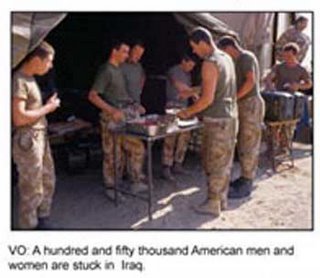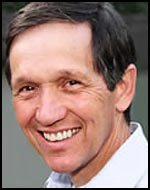I was having an argument this weekend with a friend of mine who was trying to maintain that there was "no connection" between Hussein and Al Qaeda. It caused me to go re-read many of Stephen Hayes' articles on the subject. I don't know why the White House isn't doing this on their own.
Actually, I have an idea why they don't. If they were to start making the case more strongly for this connection, inevitably something they say would be wrong which would bring a new round of catcalls and sniping that they are "lying." Actually, nothing would even need to be wrong, just a piece of evidence showing the connection contradicted by another piece of evidence that says otherwise and out would come the long knives.
I think this judgment is misplaced. Is it really possible for the left to accuse the administration of "lying" more than they already have? They are going to make the accusations regardless, get the case out there. Someone in the executive branch needs to get the evidence out there as quickly as possible.
Here is a sampling of Hayes' work on this subject that is worth reading if you haven't, and worth re-reading if you have.
From the 9-11 Commission:
Bin Ladin also explored possible cooperation with Iraq during his time in Sudan, despite his opposition to Hussein's secular regime. Bin Ladin had in fact at one time sponsored anti-Saddam Islamists in Iraqi Kurdistan. The Sudanese, to protect their own ties with Iraq, reportedly persuaded bin Ladin to cease this support and arranged for contacts between Iraq and al Qaeda. A senior Iraqi Intelligence officer reportedly made three visits to Sudan, finally meeting bin Ladin in 1994.
For those analysts and politicians, particularly in the United States, who cling desperately to the notion that there was "no connection" between Iraq and al Qaeda, Ansar al Islam presents a problem. Typical of this was an article in the July 10, 2005, issue of Time magazine. Written by former Clinton administration counterterrorism official Daniel Benjamin, the article presumptuously declared "we know there was no pre-existing relationship between Baghdad and al-Qaeda."
The evidence, of course, suggests that this analysis is wrong. Even as naysayers in the States continue to deny any connection, such staunchly anti-Iraq War publications as Le Monde have long since conceded the point. One day before the Time article, on July 9, the French daily published a news story that declared Ansar al Islam "was founded in 2001 with the joint help of Saddam Hussein--who intended to use it against moderate Kurds--and al Qaeda, which hoped to find in Kurdistan a new location that would receive its members."
On this, at least, the French are right.
Two intercepts in 2002--one in May, the other in October--illuminated the Iraqi regime's role in Ansar al Islam. The first revealed that an Iraqi Intelligence officer praised the work of the terrorist group and passed $100,000 to its leaders. The second, described in a report from the National Security Agency, reported that the Iraqi regime and al Qaeda reached an agreement whereby the regime would provide safehaven in northern Iraq to al Qaeda terrorists fleeing Afghanistan. Also, the regime agreed to fund and to arm the incoming jihadists.
The Mother of All Connections:
This unclassified document was released by the Pentagon in late March 2005. It details the case for designating an Iraqi member of al Qaeda, currently detained in Guantanamo Bay, Cuba, as an "enemy combatant."
1. From 1987 to 1989, the detainee served as an infantryman in the Iraqi Army and received training on the mortar and rocket propelled grenades.
2. A Taliban recruiter in Baghdad convinced the detainee to travel to Afghanistan to join the Taliban in 1994.
3. The detainee admitted he was a member of the Taliban.
4. The detainee pledged allegiance to the supreme leader of the Taliban to help them take over all of Afghanistan.
5. The Taliban issued the detainee a Kalishnikov rifle in November 2000.
6. The detainee worked in a Taliban ammo and arms storage arsenal in Mazar-Es-Sharif organizing weapons and ammunition.
7. The detainee willingly associated with al Qaida members.
8. The detainee was a member of al Qaida.
9. An assistant to Usama Bin Ladin paid the detainee on three separate occasions between 1995 and 1997.
10. The detainee stayed at the al Farouq camp in Darwanta, Afghanistan, where he received 1,000 Rupees to continue his travels.
11. From 1997 to 1998, the detainee acted as a trusted agent for Usama Bin Ladin, executing three separate reconnaissance missions for the al Qaeda leader in Oman, Iraq, and Afghanistan.
12. In August 1998, the detainee traveled to Pakistan with a member of Iraqi Intelligence for the purpose of blowing up the Pakistan, United States and British embassies with chemical mortars.
13. Detainee was arrested by Pakistani authorities in Khudzar, Pakistan, in July 2002.
Interesting. What's more interesting: The alleged plot was to have taken place in August 1998, the same month that al Qaeda attacked two U.S. embassies in East Africa. And more interesting still: It was to have taken place in the same month that the Clinton administration publicly accused Iraq of supplying al Qaeda with chemical weapons expertise and material.
Saddam's Al Qaeda Connection:
Finally, what if any new evidence has emerged that bolsters the Bush administration's prewar case?
The answer to that last question is simple: lots. The CIA has confirmed, in interviews with detainees and informants it finds highly credible, that al Qaeda's Number 2, Ayman al-Zawahiri, met with Iraqi intelligence in Baghdad in 1992 and 1998. More disturbing, according to an administration official familiar with briefings the CIA has given President Bush, the Agency has "irrefutable evidence" that the Iraqi regime paid Zawahiri $300,000 in 1998, around the time his Islamic Jihad was merging with al Qaeda. "It's a lock," says this source. Other administration officials are a bit more circumspect, noting that the intelligence may have come from a single source. Still, four sources spread across the national security hierarchy have confirmed the payment.
and
And there are reports of more direct links between the Iraqi regime and bin Laden. Farouk Hijazi, former Iraqi ambassador to Turkey and Saddam's longtime outreach agent to Islamic fundamentalists, has been captured. In his initial interrogations, Hijazi admitted meeting with senior al Qaeda leaders at Saddam's behest in 1994. According to administration officials familiar with his questioning, he has subsequently admitted additional contacts, including a meeting in late 1997. Hijazi continues to deny that he met with bin Laden on December 21, 1998, to offer the al Qaeda leader safe haven in Iraq. U.S. officials don't believe his denial.
For one thing, the meeting was reported in the press at the time. It also fits a pattern of contacts surrounding Operation Desert Fox, the series of missile strikes the Clinton administration launched at Iraq beginning December 16, 1998. The bombing ended 70 hours later, on December 19, 1998. Administration officials now believe Hijazi left for Afghanistan as the bombing ended and met with bin Laden two days later.
Earlier that year, at another point of increased tension between the United States and Iraq, Hussein sought to step up contacts with al Qaeda. On February 18, 1998, after the Iraqis repeatedly refused to permit U.N. weapons inspectors into sensitive sites, President Bill Clinton went to the Pentagon and delivered a hawkish speech about Hussein's weapons of mass destruction and his links to "an unholy axis of terrorists, drug traffickers, and organized international criminals." Said Clinton: "We have to defend our future from these predators of the 21st century. . . . They will be all the more lethal if we allow them to build arsenals of nuclear, chemical, and biological weapons and the missiles to deliver them. We simply cannot allow that to happen. There is no more clear example of this threat than Saddam Hussein."
The following day, February 19, 1998, according to documents unearthed in Baghdad after the recent war by journalists Mitch Potter and Inigo Gilmore, Hussein's intelligence service wrote a memo detailing upcoming meetings with a bin Laden representative traveling to Baghdad. Each reference to bin Laden had been covered with Liquid Paper. The memo laid out a plan to step up contacts between Iraq and al Qaeda. The Mukhabarat, one of Saddam's security forces, agreed to pay for "all the travel and hotel costs inside Iraq to gain the knowledge of the message from bin Laden and to convey to his envoy an oral message from us to bin Laden." The document set as the goal for the meeting a discussion of "the future of our relationship with him, bin Laden, and to achieve a direct meeting with him." The al Qaeda representative, the document went on to suggest, might be "a way to maintain contacts with bin Laden."









